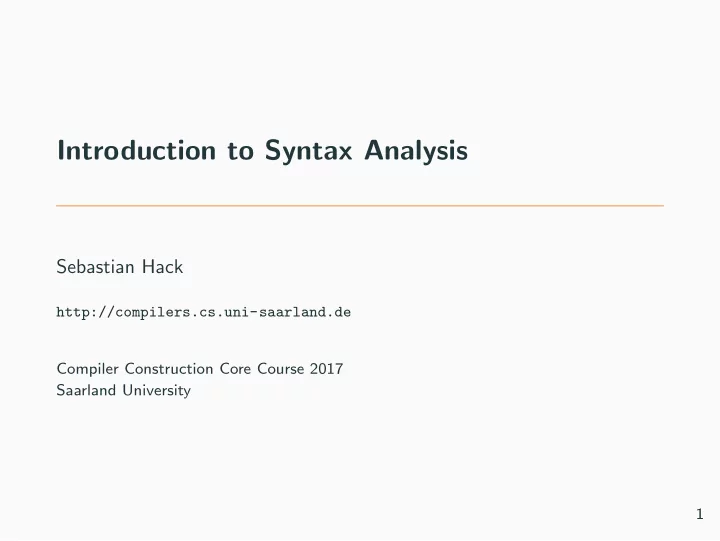

Introduction to Syntax Analysis Sebastian Hack http://compilers.cs.uni-saarland.de Compiler Construction Core Course 2017 Saarland University 1
Syntax Analysis in the Compiler Structure Text Lexer Tokens Parser AST 2
Abstract Syntax vs. Concrete Syntax Syntax is typically defined using context-free grammars Abstract syntax describes the Concrete syntax describes how structure of a program: programs “look” like as text: → While( e , s ) → while ( e ) s s s | If( e , s , s ) | if ( e ) s else s | ExprStmt( e ) | e ; → Const[ v ] → NUM e e | Id[ n ] | ID | Neg( e ) | - e | Plus( e , e ) | e + e | Minus( e , e ) | e - e . . | ( e ) . . . . 3
Lexing • The terminals of the concrete syntax are so-called tokens that are produced by a lexer from the characters of the program text • A token consists of • An ID that characterizes its type (identifier, number, semicolon, etc.) • Source code coordinates (for error reporting) • The corresponding program text (if necessary) • Structure of tokens typically described by regular expressions • Theory doesn’t require lexing (context-free languages contain regular languages) but lexing makes the specification of the concrete syntax and the parser simpler 4
Lexing: Example Program Text Tokens (coordinates omitted) q = 0; ID("q") ASSIGN INT CONST("0") SEMI r = x; ID("r") ASSIGN ID("x") SEMI while (y <= r) { r = r - y; WHILE LPAREN VAR("y") LE VAR("r") q = q + 1; RPAREN LBRACE } ID("r") ASSIGN ID("r") MINUS ID("y") SEMI ID("q") ASSIGN ID("q") PLUS INT CONST("1") SEMI RBRACE 5
Parsing • The parser analyses the token stream and • either constructs the AST • or produces error messages on syntax errors • Parsing requires an unambiguous grammar: Every syntactically correct input program has exactly one derivation • Straight-forward grammars for common languages are ambiguous, common issues: • Precedence and associativity of operators • Dangling else • We’ll discuss different solutions to this problem in the parsing session 6
Parsing Example Tokens Abstract Syntax Tree ID("q") ASSIGN INT CONST("0") SEMI Seq ID("r") ASSIGN ID("x") SEMI WHILE LPAREN VAR("y") LE VAR("r") Assign Seq RPAREN LBRACE ID("r") ASSIGN ID("r") MINUS ID("y") Var[q] Cnst[0] Assign While SEMI ID("q") ASSIGN ID("q") PLUS Var[r] Var[x] Cmp[Le] Seq INT CONST("1") SEMI RBRACE Var[y] Var[r] Assign Assign Var[r] Minus Var[q] Plus Var[r] Var[y] Var[q] Const[1] 7
Recommend
More recommend